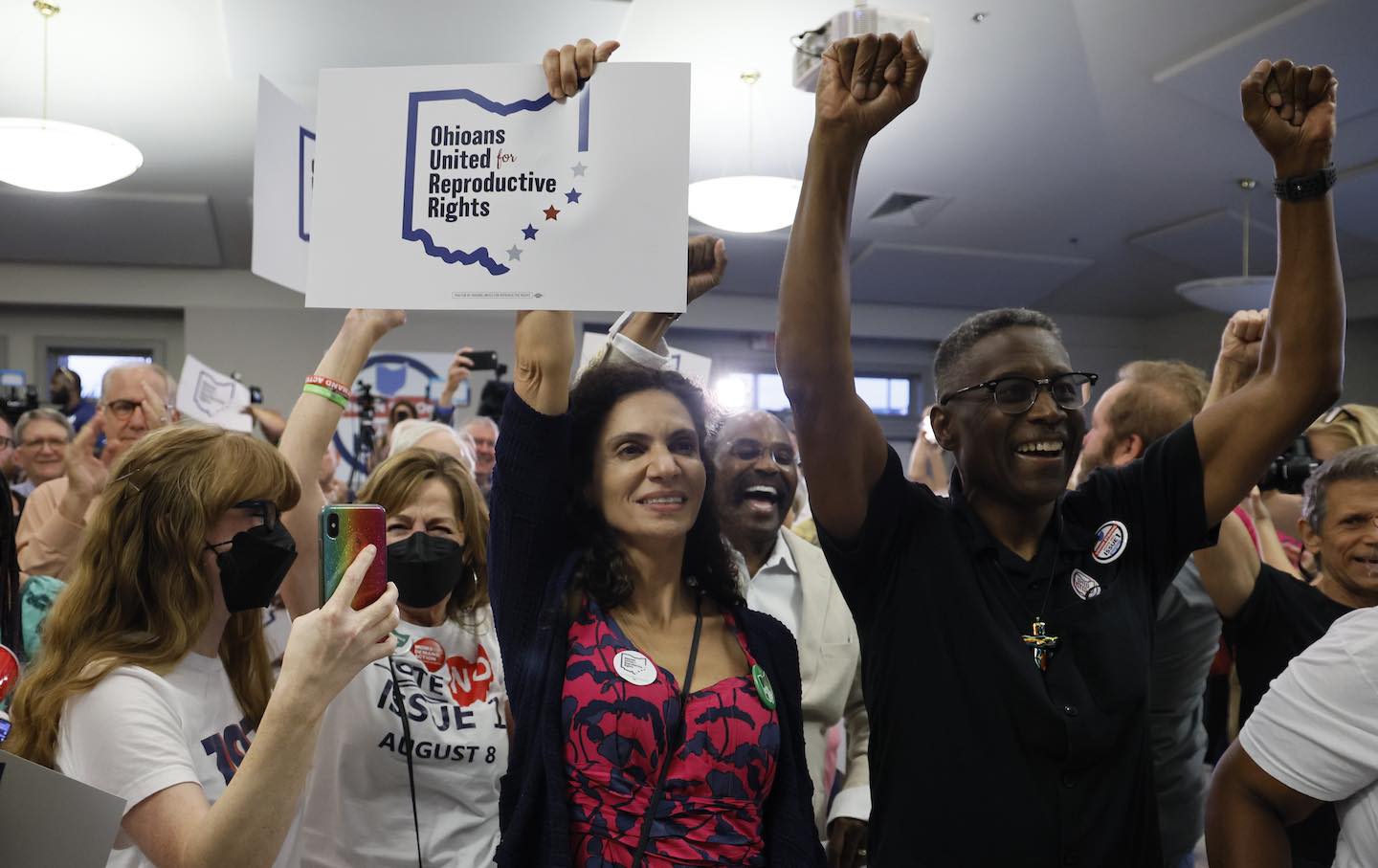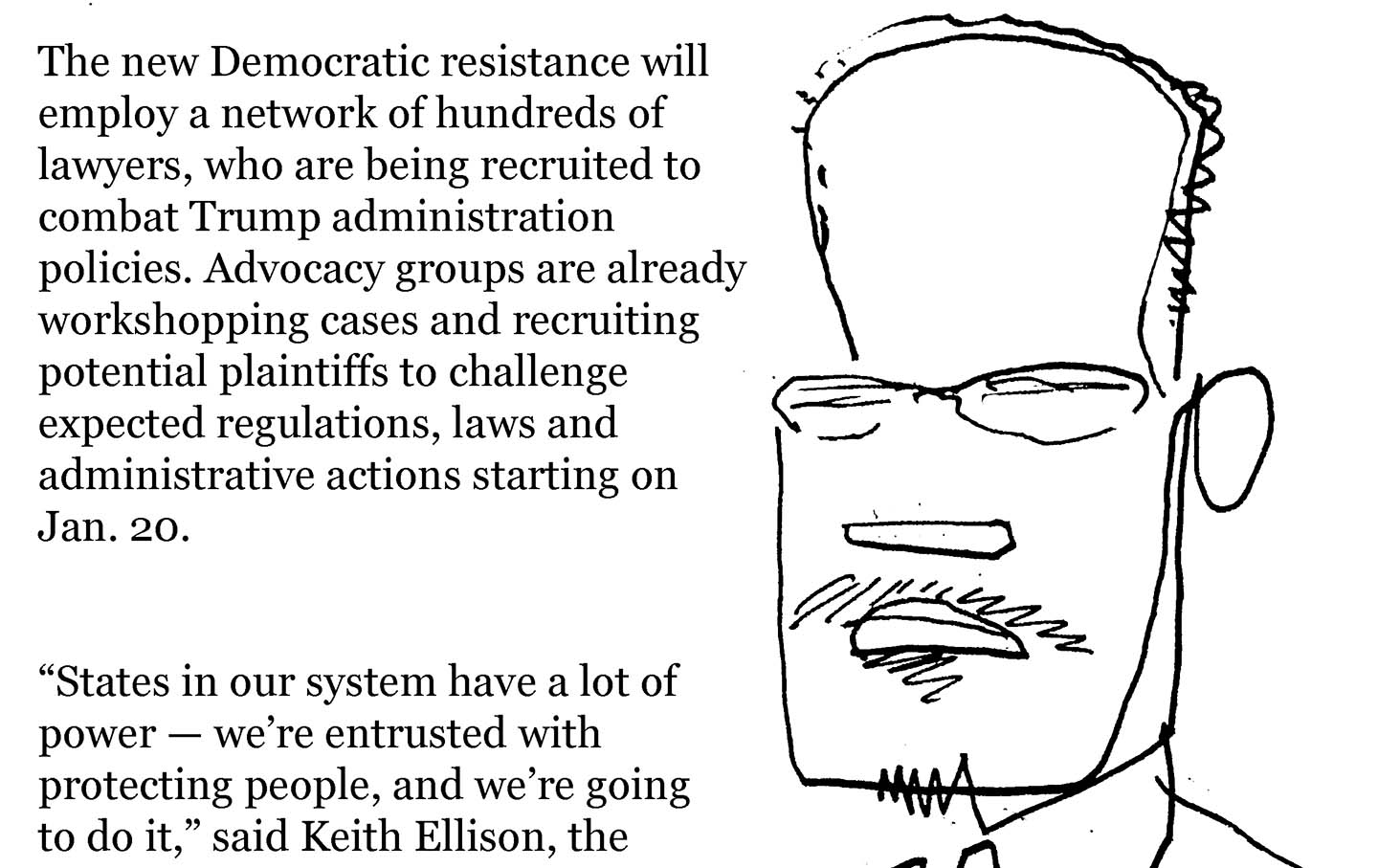A Win for Abortion Rights, a Win for Democracy: Ohio Voters Reject Issue 1
Ohio voters didn’t fall for the Republican effort to upend democracy and make it more difficult to protect abortion rights as well as other fundamental rights.

People celebrate the defeat of Issue 1 during a watch party Tuesday, August 8, 2023, in Columbus, Ohio.
(AP Photo / Jay LaPrete)There are two ways to win elections. One way is by focusing on the issues that voters care about and delivering your message in ways that encourage people to come to the polls. The other is to rig the system so that democracy is mangled to thwart the will of the people.
Ohio Republicans and their billionaire backers chose the latter approach this year, when they hatched a plan to make it dramatically harder for voters to guarantee abortion rights. After the US Supreme Court overturned the national right to abortion last year, Ohio supporters of reproductive rights made it known that they would seek to amend the state Constitution in order to guarantee access to abortion. Fearing a result similar to those from states where voters established constitutional rights to abortion (in California, Michigan, and Vermont) and rejected referendums seeking to allow abortion bans (in Kansas and Kentucky), the Ohio GOP set out to end majority rule.
Specifically, they proposed raising the threshold so that any constitutional amendment would have to secure a 60 percent supermajority in order to be enacted. GOP legislators chose as their vehicle a hastily drafted ballot measure, Issue 1, which they placed on Tuesday’s ballot in hopes that a low-turnout summer election would allow them to sneak one by the electorate.
Their plan failed, spectacularly, as voters rejected Issue 1 by a 57-43 margin in an election that saw ” off-the-charts” levels of early voting —and a final turnout of more than 3 million that exceeded all expectations.
Tuesday’s dramatic rejection of a transparent attempt to undercut popular democracy means that Ohio voters will have a chance in November to join the growing list of states that have guaranteed abortion rights. Polls suggest that Ohio’s ballot measure will be approved by a sizable margin.
“Ohioans saw Issue 1 for what it was—an attempt to deny our families a voice, even when it comes to our most personal decisions,” said Rhiannon Carnes, a spokesperson for Ohioans United for Reproductive Rights.”Now, Ohioans will turn their focus to rejecting extremism and government control to ensure families have the freedom to make decisions that are best for them. Ohioans believe that abortion is a personal, private decision that should be up to them and their families without government meddling in their business.”
There’s no question that the Ohio result represents a major win for the state’s robust reproductive rights movement. In addition, it confirms the argument by progressive strategists that abortion rights voters—many of them young, many of them women who might previously have voted Republican—will be a definitional factor in this fall’s off-year elections and in the 2024 presidential election.
But the defeat of Issue 1 also represents a major victory for one-person, one-vote democracy, at a time when the extreme right-wing forces that now dominate the Republican Party have made it abundantly clear that they will stop at nothing to prevent voters from rejecting the party’s candidates and its agenda. In addition to the higher threshold for enacting constitutional amendments, the failed Issue 1 proposal would also have increased the number of petition signatures that grassroots activists are required to collect from Ohio counties in order to qualify initiatives for the statewide ballot, creating an additional barrier to popular democracy.
While the Issue 1 vote was framed as a shadow referendum on abortion rights, passage of the proposal would also have threatened efforts to address gerrymandering, to protect the rights of LGBTQ+ Ohioans, and to defend collective bargaining for unionized workers. Organized labor was especially active in the “No on 1” campaign, with many union members recalling that, in 2011, after a Republican governor and legislature attacked collective bargaining rights, voters overruled their plan by a 62-38 margin. Decrying Issue 1 as “a political ploy by extreme special interests to permanently change Ohio’s Constitution in their favor,” the International Brotherhood of Electrical Workers warned members that “40.01 percent of voters could defeat 59.99 percent on a future ballot measure to ban right-to-work laws, meaning a minority of Ohioans would be enough to weaken unions and the power of collective bargaining.”
Ohio’s One Person, One Vote coalition—which brought together Ohio’s AFL-CIO and ACLU, Sierra Club and Farmers Union, League of Women Voters and YWCA, among others— recognized that, as abortion rights campaigners have argued since last year’s Dobbs decision came down, the assault on abortion access is just the beginning of an assault on all the freedoms that have been secured and sustained via the democratic process.
Tuesday’s win gave a boost to progressives in the Buckeye State, where Republicans hold the governorship and most statewide offices, and dominate the state legislature. Democratic US Senator Sherrod Brown, who was an outspoken “No on 1” campaigner, faces a tough reelection campaign in the state next year, and the groundwork that was laid in 2023 is likely to benefit that bid. During the campaign, Brown declared that the ballot measure was “about powerful people trying to get more power—at Ohio’s expense.”
The Ohio result also gave encouragement to democracy activists nationwide, who know from experience that the assault on popular democracy is not just an Ohio phenomenon.
Popular
“swipe left below to view more authors”Swipe →Almost two decades ago, the American Legislative Exchange Council, a corporate-backed group of conservative legislatures that is highly influential in Republican-controlled state capitols, proposed a model “Resolution to Reform the Ballot Initiatives Process,” which sought to make it harder to qualify referendum language and suggested that proposals on fiscal issues should require supermajorities to become law. In recent years, other groups, particularly the conservative Opportunity Solutions Project (OSP)—the leadership of which has ties to ALEC— have taken up the project. Last fall, the Ohio Capital Journal reported that
The Ohio House effort to make amending the state constitution more difficult has been notable thus far for its lack of public support. In committee hearings and press conferences opponents have lined up against the proposal. Indeed, despite the resolution’s rapid progress, 140 interest groups have already signed on denouncing the plan.
Although three organizations have voiced support for HJR 6 with written testimony, none had shown up to advocate for the proposal in person. That changed Thursday….
[OSP visiting fellow Travis N. Taylor] argued the changes proposed for Ohio’s Constitution are a “simple reform with strong roots in American constitutionalism.” Demanding broad consensus for passage, he argued, insulates the constitution from frivolous changes.
After a heated campaign that saw massive spending on both sides of the issue—including a $4 million outlay on behalf of Issue 1 by Illinois billionaire Richard Uihlein, a top Republican donor—voters made it clear that they don’t see an amendment to protect reproductive rights as “frivolous.”
But that doesn’t mean that Republican efforts to upend democracy will stop. In Missouri, for instance, voters will determine in November the fate of a Republican scheme to raise the threshold for approval of amendment proposals to a 57 percent supermajority.
Still, the win for abortion rights signals that the issue will remain a deciding factor for voters in the elections of 2023 and 2024. It also signals that Republican schemes to upend democracy will be rebuked. “By rejecting Issue 1,” announced an energized Sherrod Brown on Tuesday night, “Ohioans rejected special interests and demanded that democracy remain where it belongs—in the hands of voters, not the rich and powerful.”
We cannot back down
We now confront a second Trump presidency.
There’s not a moment to lose. We must harness our fears, our grief, and yes, our anger, to resist the dangerous policies Donald Trump will unleash on our country. We rededicate ourselves to our role as journalists and writers of principle and conscience.
Today, we also steel ourselves for the fight ahead. It will demand a fearless spirit, an informed mind, wise analysis, and humane resistance. We face the enactment of Project 2025, a far-right supreme court, political authoritarianism, increasing inequality and record homelessness, a looming climate crisis, and conflicts abroad. The Nation will expose and propose, nurture investigative reporting, and stand together as a community to keep hope and possibility alive. The Nation’s work will continue—as it has in good and not-so-good times—to develop alternative ideas and visions, to deepen our mission of truth-telling and deep reporting, and to further solidarity in a nation divided.
Armed with a remarkable 160 years of bold, independent journalism, our mandate today remains the same as when abolitionists first founded The Nation—to uphold the principles of democracy and freedom, serve as a beacon through the darkest days of resistance, and to envision and struggle for a brighter future.
The day is dark, the forces arrayed are tenacious, but as the late Nation editorial board member Toni Morrison wrote “No! This is precisely the time when artists go to work. There is no time for despair, no place for self-pity, no need for silence, no room for fear. We speak, we write, we do language. That is how civilizations heal.”
I urge you to stand with The Nation and donate today.
Onwards,
Katrina vanden Heuvel
Editorial Director and Publisher, The Nation








